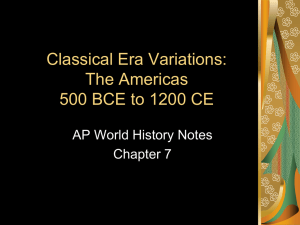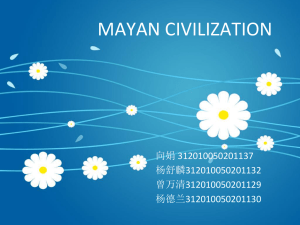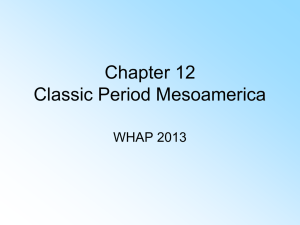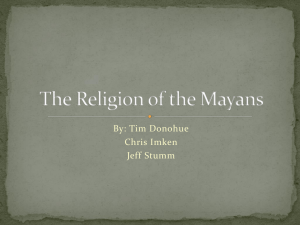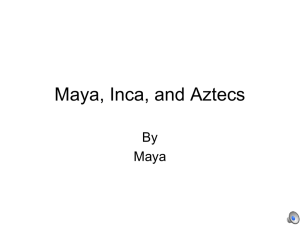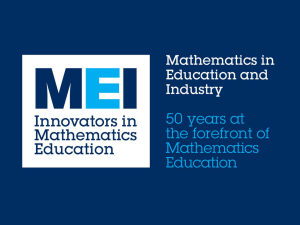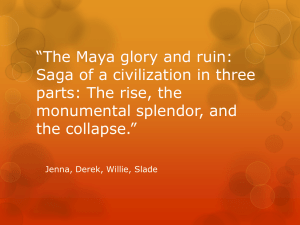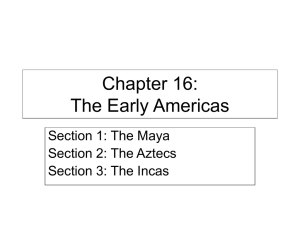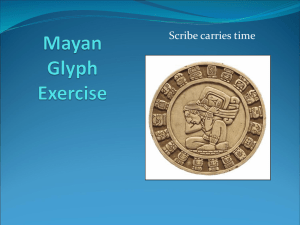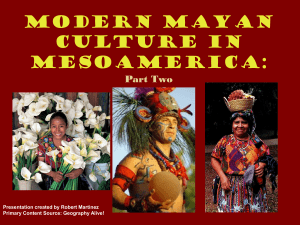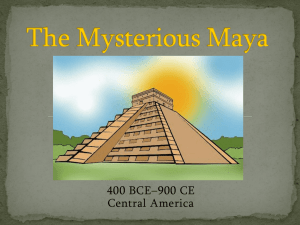Maya Hieroglyphic Language
advertisement
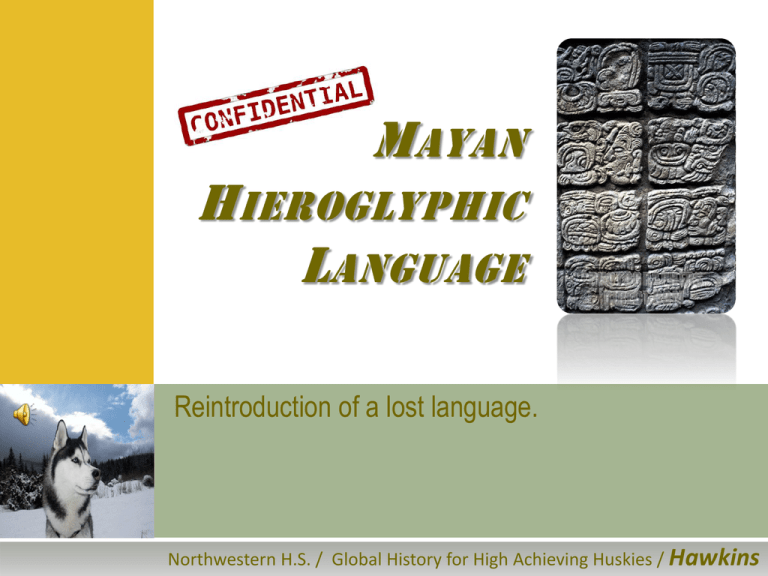
M AYAN H IEROGLYPHIC L ANGUAGE Reintroduction of a lost language. Northwestern H.S. / Global History for High Achieving Huskies / Hawkins A RMATURE L INGUISTIC T OOL K IT Rule #1 count the signs or Symbols •If a script has 20 -35 signs or symbols then it’s probably •alphabetical. Representing simple sounds. •Ancient Somalian for example. Question: Mayan Hieroglyphic Language has around 800 symbols…. what might we conclude? •If a script has 80 -100 signs or symbols then it’s probably based on syllables. Native American Cherokee for example. •If a script has hundreds of signs or symbols then it’s probably logographical. A language where each sign represents whole words, like Chinese has thousands of symbols for thousands of words. Scholars assumed The Mayan system was a Limited logographical System. •With such a rich inventory of signs, both logographic and syllabic, the ancient Maya scribe combined them in bewildering ways for both functional and aesthetic purposes, hence the assumption. •Scribes could and did write the same word in multiple ways. Sometimes only logograms were used. •Other times just phonetic signs were employed. And sometimes logograms are accompanied by phonetic complements, phonetic signs that serve to clarify the reading of the logogram by either spelling out the beginning or ending sound of the word. •One reason for the use of phonetic complements is that a sign can have multiple functions, a phenomenon called polyvalence. W ORD - •It is also possible that a glyph can function as both logogram and phonetic sign. •For instance, the phonetic sign ku is also the logogram TUUN and the calendrical sign for the tzolk'in day Kawak •. In this case, the logogram TUUN is usually followed by the phonetic complement ni to indicate its reading. •The Kawak sign would also be easily distinguished because of numeric sign before it and its location in a Calendar Round or Long Count block….but let’s go back to how this complicated language got lost in the first place. H ISTORICAL R EFERENCE : THE DEATH OF A CULTURE- Diego de Landa Franciscan priest and bishop of Yucatán. Modern scholars regard Landa with a mixture of frustration and admiration. At the same time he wrote his comprehensive work on Mayan culture, his orders to destroy all icons and hieroglyphics obliterated the Mayan language forever, helping to undermine and destroy the civilization he so vividly described. •Upon learning that the Mayans were Still making offerings to ancient gods Diego de Landa arrested and tortured thousands of Mayans for devil worship. Only four incomplete codex survived. •He implemented a primitive inquisition that destroyed most of Mayan artifacts. He held a “Great Ceremony Of Destruction” in the central plaza and burning every Mayan manuscript available. •Diego de Landa viewed the Mayan texts as A tool of the devil and forced Mayan scribes learn European script. Under prosecution of being burned at the stake for writing in the ancient language, Mayan Hieroglyphics died out by the 1800’s. D IEGO DE L ANDA C RIMES AGAINST THE M AYAN C ULTURE 1500 years of history destroyed in the name of Catholicism. T IME L INE : CRACKING THE MAYAN CODE • In 1774, Spanish explorer Jose Calderon finds remains of Mayan City Palenque. Inside the temple the explorer and his men found huge stone tablets with Hieroglyphic carvings. •1810 Three Mayan books resurface, one in Madrid, another in Paris and the most famous in the Royal Library of Dresden Germany it’s called the Dresden Codex. 5 pages of the Dresden Codex are printed in a Paris publication regarding communications in the Americas. Time Line: Continued •1832 Constantine Samuel Rafinesque: •his explanation of the bar-and dot symbols representing fives and ones, respectively, constitutes the first instance of successful decipherment of ancient Mayan. E RNST F ORSTEMANN 1 8 8 0 R OYAL L IBRARY OF D RESDEN •Facsimile reproduction of Dresden Codex by Ernst Forstemann,1880 with commentary. This was an early example of a "photographic" process known as "chromolithography". •The black and white images were reused for an 1892 edition. Possibly the material that was found in WWII by Yuri Valentinovich Knorozov. •Forstemann discovered the date the Mayan ‘s thought the universe began4 Ahau 8 Cumka [August 13th 3114 BC] •This allows field researchers to establish important dates on the Mayan stelae, critical to the work of Thompson and Proskouriakoff. A LFRED M AUDSLAY 1880 PHOTOGRAPHER • Arrives with Glass plate camera starts documenting the Mayan carvings in the city states of Quirigua, Copan, Tikai • This becomes the informational foundation from which the ancient language is resurrected. Why is this Important? J. E RIC S. T HOMPSON 1930’S- 1960’S •Thompson did considerable work in deciphering of Maya hieroglyphics, especially those related to the calendar and astronomy, as well as identifying some new nouns. •He developed a numerical cataloguing system for the glyphs (the T-number system) which, with some expansions, is still used by Mayanists today. •His attempted decipherments were based on ideographic rather than linguistic principles. In his later years he resisted the notion that the glyphs have a strong phonetic component, as put forward by the Russian linguist Yuri Knorozov. •After his death, for a time some younger Maya epigraphers blamed Thompson for holding back what became a very fruitful approach to the glyphs with his forceful and articulate disagreements. Y URI V ALENTINOVICH K NOROZOV R USSIAN L INGUIST A Russian solider he became a linguist after finding a copy of the codexs in a bombed out library. What set Knorozov apart was that he realized Landa's alphabet was really part of the Maya syllabify, and he succeeded in identifying many of the syllabic glyphs. Knorozov knew that no on language is made up entirely of one system our own system uses numerals and logograms. He realized that the Mayan systems combined phonetic signs and word signs. He based his phonetic Understandings on the works of Diego de Landa. He used the Madrid Codex to decipher the word for “west” based on combining Landa and Thompson’s academic theories. •Thompson’s anti-communist political agenda discredits Knorozov’s phonetic theories. T ATIANA P ROSKOURIAKOFF E P I G R A P H E R , E T H N O L O G I S T, A N D A N A R C H A E O L O G I S T 1936-1975 Tatiana Proskouriakoff studied to be an architect at Pennsylvania State University . Attaining access to the Penn Museum, she volunteered to draw for one of the curators there. This work impressed the archaeologist Linton Satterthwaite, who invited her to join his 1936 expedition to Piedras Negras in northwestern Guatemala. Piedras Negras was a classical site of Mayan ruins that Satterthwaite had been excavating for some time. Over the next few years Proskouriakoff produced a series of reconstructive drawings depicting ancient Mayan cities This stela helped to prove that the Maya inscriptions spoke of history. In 1960, Tatiana Proskouriakoff, suggested that these "niche" scenes represented rulers newly seated on their thrones. She pointed out that the "niche" stelae always carried the earliest dates of their series and that a certain set of "inaugural" hieroglyphs followed those dates whenever they appeared in later texts. This breakthrough led to the recognition of birth and death glyphs, the name-glyphs of the rulers, parentage information, the capture of enemies, and other biographical items from the lives of the Maya rulers. BEAUTY AND BRAINS Pioneering woman in the field of Maya archaeology Tatiana began to notice a sequence of dates and signs in the hieroglyphic transcriptions. She identified a series of seven rulers in a time span of 200 years. She was also able to prove that these texts showed rites of passage and major accomplishments of the rulers. Her studies of the stelae of Piedras Negras influenced the way archaeologists today incorporate glyphic data to reach interpretive results. While touring Palenque, Linda Schele met the famed artist and photographer of Maya ruins, Merle Green Robertson, who became Schele's most important mentor during the early stages of her new vocation. The association with Robertson quickly drew Schele into the world of the ancient Maya, their art and their system of hieroglyphic writing. In 1973, Robertson organized the first Mesa Redonda de Palenque, a small conference whose goal was deciphering Maya writing, a hieroglyphic system, at that time not fully understood. Participating In that conference, and working with Peter Matthews, Schele used her knowledge, vision and a compilation of recent epigraphic breakthroughs to decipher a major section of the Palenque King List. This achievement became the stimulus that led to many later discoveries by Schele and other scholars. R OBERTSON / S CHELE / M ATTHEWS Dr. David Stuart Linda and David Schele Professor of Mesoamerican Art and Writing David began deciphering Mayan hieroglyphs at the age of 8, under the tutelage of his father and later Linda Schele. He presents first paper on Mayan Hieroglyphic language at age 12 In 1983, at the age of 18, he became the youngest-ever recipient of a Mac Arthur Fellowship "genius grant”. His publications include Ten Phonetic Syllables (1987), which laid much of the groundwork for the now-accepted methodology of decipherment. In 2003 he published a volume ongoing series Corpus of Maya Hieroglyphic Inscriptions, devoted to drawings and photographs of sculpture from Piedras Negras, Guatemala.
